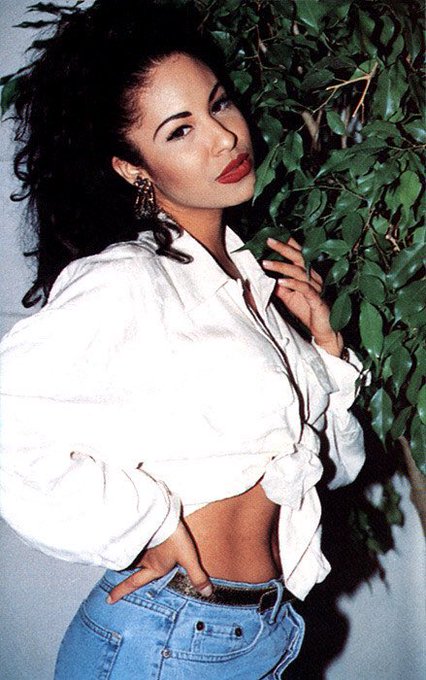
Wikimedia Commons Yolanda Saldivar.
Yolanda Saldivar’s twisted devotion to Tejano superstar Selena Quintanilla as her fan club president turned into obsession and, in 1995, she murdered the young music icon in a Corpus Christi, Texas motel room.
Saldivar did not manage to extinguish the light that was Selena, however. It’s hard to imagine, but Selena would have been in her 40s in 2017, as she died at age 23. She is immortalized in sequined costumes and YouTube videos that capture the youthful vibrance and warmth that made her an icon, and she is considered a trailblazer today.
Selena was honored in an October 17 Google Doodle, and lauded by Google as a “Mexican-American music and entertainment icon, fashion trendsetter, passionate entrepreneur” and community philanthropist, who transcended cultural boundaries and achieved crossover stardom after death.
That has a lot of people wondering what happened to Yolanda Saldivar, the woman who so cruelly cut Selena’s promise so short. Despite rumors that she has died, Saldivar is not dead. She is serving a life prison term, but she could seek parole in only eight more years.
Here’s what you need to know:
1. Saldivar Murdered Selena in a Motel Room After the Singer’s Family Suspected Her of Stealing
When Selena Quintanilla was murdered in 1995 by Yolanda Saldivar, the former nurse had embedded herself in the Tejano superstar’s professional life, presiding as president of her fan club and manager of her clothing boutique. Selena was shot to death by Saldivar in a Texas motel room at only age 23, as Selena was on the brink of major crossover success, according to CNN.
The question at trial: Saldivar tried to claim that Selena was accidentally shot. The jury didn’t buy it.
According to a 1995 New York Times story on Saldivar’s conviction, the “jury here in Houston took less than two and a half hours to convict the defendant, Yolanda Saldivar, apparently rejecting the contention of her lawyers that the gun that killed Selena, who was 23, had gone off accidentally and that Ms. Saldivar had really meant to kill herself.”
At the time, Saldivar was 35.
The prosecutor described in closing arguments how Saldivar “took the gun out, cocked the hammer, pulled the trigger and killed her” at a Days Inn motel, adding, “What could be a worse way to die than to be shot in the back in a cowardly manner?”
Selena’s family suspected Saldivar of stealing money from Selena, sparking the final row that led to murder.
The Times reported that Saldivar was sentenced to life in prison who no possibility of parole for 30 years. The newspaper noted that “Saldivar, the founder and former president of Selena’s fan club, was confronted on March 9 by relatives of the 23-year-old singer, whose full name was Selena Quintanilla Perez. They accused Ms. Saldivar of embezzling money from Selena’s business interests.” Selena and Saldivar then had their fatal meeting at the motel.
Recounted Texas Monthly in chilling detail, “Selena asked for the bank statements. Apparently, she also attempted to sever their professional relationship. Harsh words were exchanged. Yolanda demanded that Selena return a ring she’d given her as a gift from her employees. As Selena removed the ring, Yolanda pulled out the gun. When Selena ran out the door and yelled for help, Yolanda screamed, ‘You b*tch!’ and shot her in the back.”
In life and after her death at Saldivar’s hand in 1995, Selena lived on. She “became a beacon of inspiration and hope for the Latinx, immigrant, and bicultural communities around the globe. Her story of embracing and celebrating all parts of her cultural heritage and persevering in the face of adversity forged an emotional connection with millions,” wrote Google.
Google has created additional content to educate the public about the life and contributions of the Tejano music legend, including an online exhibit. You can see it here.
Saldivar is incarcerated, but she can request parole in 2025, according to Latina.com. Specifically, she is ineligible for parole until March 30, 2025, despite fake news reports that falsely said she had been released early.
2. Saldivar Took Years to Admit the Motive for the Murder: Covering Up an Embezzlement
It took Saldivar two decades to admit why she murdered Selena.
According to Latina.com, 22 years after she snuffed out the life of the music icon, Saldivar discussed her motive.
She told Televisa, according to Latina.com, that “she killed her because she wanted to feign an assault to avoid going to jail and, above all, not have to pay her the almost 200 thousand dollars she had stolen during her administration of clothing stores and the Selena fan club.”
Saldivar has made outlandish claims from her jail cell.
Saldivar gave an interview behind bars in which she claimed that Selena was pregnant when she died, although Selena’s husband, Chris Perez, has disputed that, according to Vivala.
The site reported that Saldivar has complained about her life behind bars. “Saldivar says that she is locked up behind bars 23 hours of the day and is only given a one hour recreation break a day. She said that once she is allowed to be outside, no other inmate is permitted to be outside with her at the same time. Saldivar also said that the inmates aren’t allowed to go near her or speak to her. She’s in full seclusion,” Vivala reported.
3. Before the Murder, Saldivar Was Described as Possessive of Selena & Created a ‘Shrine’ to Her
According to Texas Monthly, although devoted to Selena, there were signs that something was amiss before Saldivar turned murderous. “She was possessive and controlling…She was a loner who had lived with her mother until recently and had few friends. She had once been accused of embezzling funds from a previous employer, and she had defaulted on a student loan,” reported Texas Monthly, adding that Saldivar had turned her apartment into “like a shrine.”
The magazine wrote of Saldivar that “Yolanda Saldivar fit the classic stereotype of la dueña, the faithful chaperone or assistant. Neither attractive nor charismatic, the short, pudgy registered nurse from San Antonio was Selena’s constant companion.”
This demeanor stood in contrast to the dynamic Selena. Her husband recounted in a book he wrote on her: “With the journalists, Selena was as personable as ever, giving each media personality a warm hug and a big smile, winning them over before she ever had to say a word. As a third- generation Texan who had to learn Spanish phonetically, with her father coaching her on her accent, she knew that there was a chance that the Mexican fans might dismiss her,” he wrote.
“Instead, they adored everything about her, from her dark hair and brown eyes to her curvy figure. The fans saw Selena’s sincerity and generosity, and felt her love for them. Selena appealed to everyone from excitable preteen girls who wanted to dress and dance like her, to abuelas who loved those heart- wrenching ballads like ‘Como La Flor.’”
In spring 2017, 22 years after her death, Selena’s father spoke emotionally about her to KSAT-TV, saying, “In my mind she’s still alive. You get involved with doing things for her every day that sometimes I forget that she’s not here with us anymore. So, in a way, it’s hard to explain, but in my mind, she’s alive.”
If he could say something to her one more time, he told the television station, “I would just hug her. I wouldn’t let her go.”
4. Saldivar Filed a Lawsuit Against the Prison After She Fell Out of a Bunk Bed
Yolanda Saldivar has complained about mistreatment in prison, according to Latina.com.
In July 2016, “Selena Quintanilla’s killer Yolanda Saldívar sued the Mountain View prison in Gatesville, Texas for denying her medical attention,” the magazine reported. “After falling from her bunk bed in May 2015, the prisoner, who hit the right side of her head, claimed she was in tremendous physical pain and emotionally distressed. The lawsuit was priced up to $500,000 for abuse and refusing to treat her medical need.”
However, a court dismissed her allegations for want of evidence.
Representing herself from prison, Saldivar has also attempted to argue that there were problems in her case, according to The San Antonio Express News. She argued that the defense counsel “failed or refused to interview witnesses and introduce any exculpatory physical evidence” into her case, the newspaper quoted the prosecutor as saying. She has not been successful in this effort, either.
Meanwhile, Selena’s legacy lives on.
In a special report on the 20th anniversary of Selena’s death, CNN noted how unusual Selena was in the world of music at the time she lived. “When Selena was breaking concert attendance records at home and abroad, there weren’t a lot of crossover pop stars who looked like her in the United States.
There was Rita Moreno and Gloria Estefan and … well, that’s about it,” CNN noted.
The network added that Selena’s death turned her into the crossover sensation she was on her way to becoming anyway, as English-speaking fans learned about her music and life.
At the time she died, Selena’s “first English-language album was months from release. Her death made international headlines,” noted CNN.
5. Selena Quintanilla Joined a Family Band When She Was Nine & Was Known as the Queen of Tejano Music
If Saldivar was initially drawn by Selena’s charisma and stardom, so, too, were millions of people, especially those of Mexican descent who were living in Texas. Selena was “born in Lake Jackson, Texas on April 16, 1971,” notes Google. “Selena’s talent shone from an early age. Strumming Nat King Cole’s ‘I’m in the Mood for Love’ on guitar, Selena’s Father listened to his daughter sing along, and immediately knew the bright future before her.”
The family soon formed its own band.
“With encouragement from their father, nine year old Selena and her older siblings A.B. (guitar) and Suzette (drums) formed the beginnings of the Tejano sensation Selena y Los Dinos,” wrote Google.
According to Biography.com, “Selena grew up speaking English, but her father taught her to sing in Spanish so she could resonate with the Latino community. She learned the lyrics phonetically at first, and eventually learned to speak Spanish fluently.”
It was this “duality” that would help make her the first Tejano superstar, according to Texas Monthly, which noted, “Her music validated the cultural duality of the majority of her fans, proving you could embrace the traditions of the land you came from while still being hip and modern.”
As Texas Monthly explained, to “the five million Texans of Mexican descent,” Selena “was more than a celebrity. She was an icon. Her status as an entertainer who was a millionaire at age nineteen; her positive personality; her devotion to God, family, and home; and her willingness to talk to kids about staying in school and avoiding drugs made her a hero to brown-skinned people—especially Hispanic girls—who had precious few role models.”
According to Biography.com, Selena “was considered the ‘Queen of Tejano,’ a type of Mexican music that incorporated other styles, such as country. She was also sometimes referred to as the ‘Mexican Madonna’ for her sexy outfits and dance moves.”
“Born in Texas, Tejano music (or “Tex-Mex”) blends Mexican and American sub-genres like pop, polka, ranchera, and cumbia. Widely popular across the TX/Mexico border since the 1800s, Selena y Los Dinos’ infectious brand of Tejano music popularized the genre to audiences globally,” Google explained.
Selena had a string of hits, including “Dreaming of You,” “I Could Fall in Love,” and “Bidi Bidi Bom Bom.”
According to Time Magazine, “She spent many of her teenage years on the road and landed a contract with recording giant EMI in 1989. Her album Live earned her a Grammy for the Best Mexican-American Album category in 1994.”
Biography.com notes, “Her 1990 album, Ven Conmigo, was the first Tejano record to achieve gold record status, meaning it sold more than 500,000 copies. In 1992, Selena took enough of a break from her hectic schedule to marry Chris Perez, the band’s lead guitarist, that April.”







